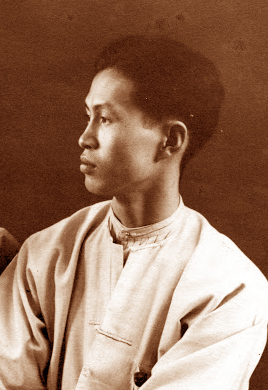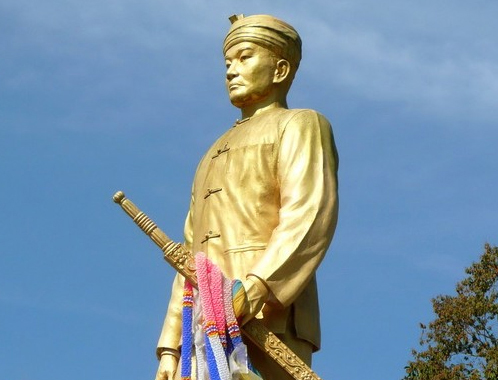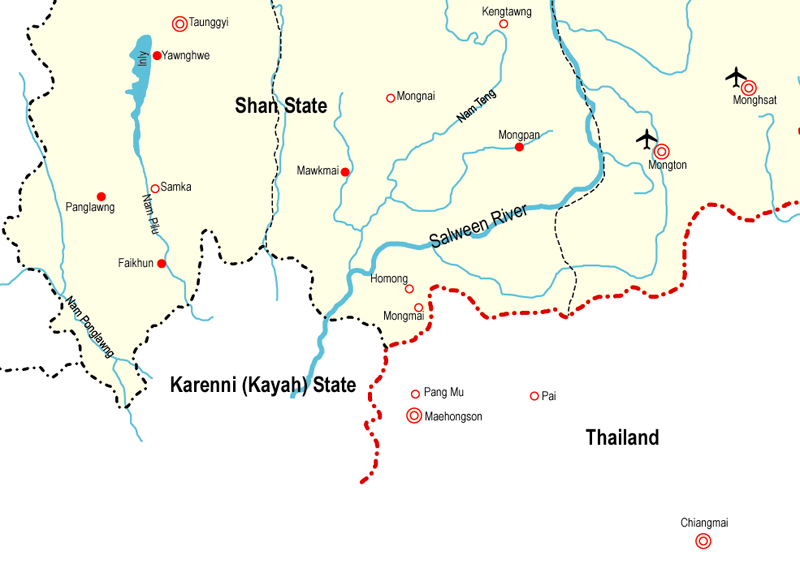My presentation will focus on the history of how Maehongson became part of Thailand from the standpoint of Shan and British scholars, as well as oral statements made by non-scholastic people. I hope the findings will be of interest to the local people here, if not to others.
A presentation by
Khuensai Jaiyen
at the
International Conference on Shan Studies (ICSS), Maehongson, 29-30 June 2013
First of all, I have a confession to make. That is I’m not a historian but merely a reader of history.
An apology is also in order, because I had been traveling most of the time and had very little time to prepare my presentation.
 My presentation will focus on the history of how Maehongson became part of Thailand from the standpoint of Shan and British scholars, as well as oral statements made by non-scholastic people. I hope the findings will be of interest to the local people here, if not to others.
My presentation will focus on the history of how Maehongson became part of Thailand from the standpoint of Shan and British scholars, as well as oral statements made by non-scholastic people. I hope the findings will be of interest to the local people here, if not to others.
My main reference will be the research paper written by one of the foremost Shan scholars, Sao Saimong Mangrai. It bears a simple title “The Shan State and the British Annexation”, has 410 pages and was published in 1965 (B.E. 2508).
Before going to the Shan-British version, I think it would be best to recount what we in Thailand know about Maehongson:
- Around 1317 (B.E. 1860), Shans from Shan States arrived in Maehongson, and established Pai
- Around 1831 (B.E. 2374), Ban Pang Mu was established by Phakka Mawng
- Later another village named Mae Hawng Sawn (Maehongson) was established by his son Saenkom
- Around 1856 (B.E. 2399) Shan States was at war and many people fled to Pang Mu and Maehongson. One of them was “Shan Galay” (The Shan Kid), who some say was a native of Samka, one of the Shan States bordering the Karenni (known as Yang Daeng in Maehongson) areas. Some chroniclers depicted him as one of the top warriors of the famous Kolan, the fighting prince of Mawkmai. Shan Galay later married Kham Hsai, Phakka Mawng’s daughter, but she died later.
- Around 1866 (B.E. 2409) there was war between Mawkmai and Mong Nai. The former came off worse and took refuge in Maehongson. His niece (some say his granddaughter) Nang Mya aka Nang Myawaddy married Shan Galay
- In 1873 (B.E. 2416) Shan Galay was conferred the title “Singhanart” by Chiangmai. A year later he became Singhanart Raja (King)
- In 1884 (B.E. 2427), he passed away and his widow Sao Nang Mya succeeded him. She too passed away in 1891 (B.E. 2434)
One conclusion that could be drawn from the Thai chronicles is that Maehongson had drawn its breath non-stop under the banner of Chiangmai and later of Bangkok, after Chiangmai accepted the latter’s overlordship.

The Shan-British version, according to Sao Saimong, much respected both among Shan and foreign academics, however differs from the Thai’s in its details, though sharing the same outline:
- Siam, as Thailand was then known, was buying slaves, until King Chulalongkorn outlawed slavery in 1874 (B.E. 2417). Karenni chiefs, including its most famous and colorful one Sawlapaw of Kantarawaddy (1866-1889), launched raids on the neighboring Shan States, including Mawkmai and Samka (as far as Ywangan, northwest of today’s Taunggyi), to capture people and sell them to slave traders in Siam
- His Shan nemesis was Nai Noi, the prince of Mawkmai. According to local legends, he was a big man. “When he squatted, his knees and his head were on the same level.” He had campaigned successfully against the Karenni raiding parties and was bestowed a respectful nickname, Kolan (meaning 9 fathoms or 54ft) by the Burmese who had fought alongside him. He was said to have been escaped from the Mandalay palace jail, where he was imprisoned for failure to pay his annual tributes, by pole jumping (pole vaulting) over the palace wall
- Later, as Mawkmai went under Burmese rule, he crossed the Salween and founded Mongmai (now a small village south of Homong) and used it as a base to launch operations against the Burmese
- The Shan-British version did not mention when he returned to Mawkmai as a conqueror. But all records agree that Shan princedoms rose up in revolt and drove out their Burmese rulers in 1882 (B.E. 2425)
- While still in Mongmai, he also attacked Maehongson and drove out Taiktaga Sa (aka Khun Sa), who was appointed by Chiangmai, and gave it to his niece Sao Nang Mya, said to be “a lady of some character.”
Her domain encompassed all of Kolan’s areas south of the Salween. It, of course included today’s Homong, Mongmai and Namonlong, now well inside Burma.

Sao Nang Mya, on becoming chief, dismissed her husband, recalled Taiktaga Sa from exile and raised him to her bed. Sao Saimong remarked it was probably to gain the much-needed local knowledge and influence. Later (definitely after the death of Kolan) she switched her allegiance from Mawkmai to Chiangmai, Maehongson being nearer to the latter.
- 1885 (B.E. 2428) British occupied Mandalay, then Burma’s capital
- 1887 (B.E. 2430) Shan States accepted British overlordship
- 1889 (B.E. 2432) British government agreed to proposal by Siamese Foreign Minister Prince Devawongse to hold a boundary commission
Ney Elias, the British commissioner, who arrived at Ta Hwepong the Salween crossing north of Homong, was met by a Siamese major Luang Ranron (I have not been able to find a Thai spelling for this), who withdrew after enquiries made by Elias.
- 1894 (B.E. 2437) 17 October, King Chulalongkorn and the British minister in Bangkok formally exchanged maps showing the boundary line as it appears today
Some answers and questions
I think the Shan-British version answers some important questions:
- Why there was fighting in the Shan States
- Why Kolan was in Maehongson
- Shan Galay’s Shan name. As he was Shan, it was strange that he didn’t seem to have a Shan name. But according to Sao Saimong, his given name was obviously “Sa”.
“Taiktaga” meanwhile was a Burmese title:
Taik: meaning building (Kuti) in a monastery or an administrative circle the equivalent of Thailand’s tambon
Taga: meaning donor, supporter or patron
The combined meaning therefore would be either donor (donor of monastic building) or (administrative headman, or Kamnan in Thai and Heng in Shan), but more likely the former rendering.
Of course, interesting questions such as the following remain:
- What would have happened, if Sao Nang Mya continued to be loyal to Mawkmai? Will today’s people of Maehongson be happy under Burmese rule?
- What about the Shans who had fled to Maehongson after Burmese occupation in 1952 (B.E. 2495)? Are you happier here than when you were in Shan State? Do you also want Maehongson return to Shan State under present circumstances?
With these questions, I humbly beg to return the floor to the facilitator.



